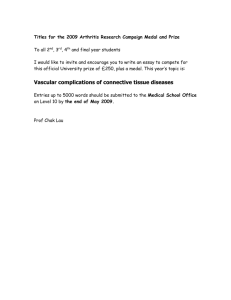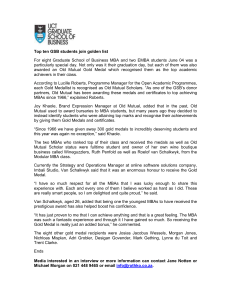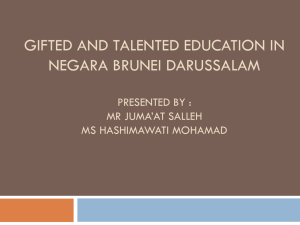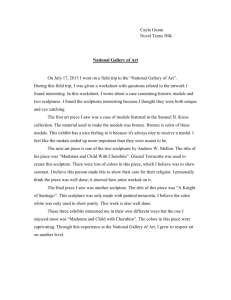click on this link. - Medal Collectors of America
advertisement
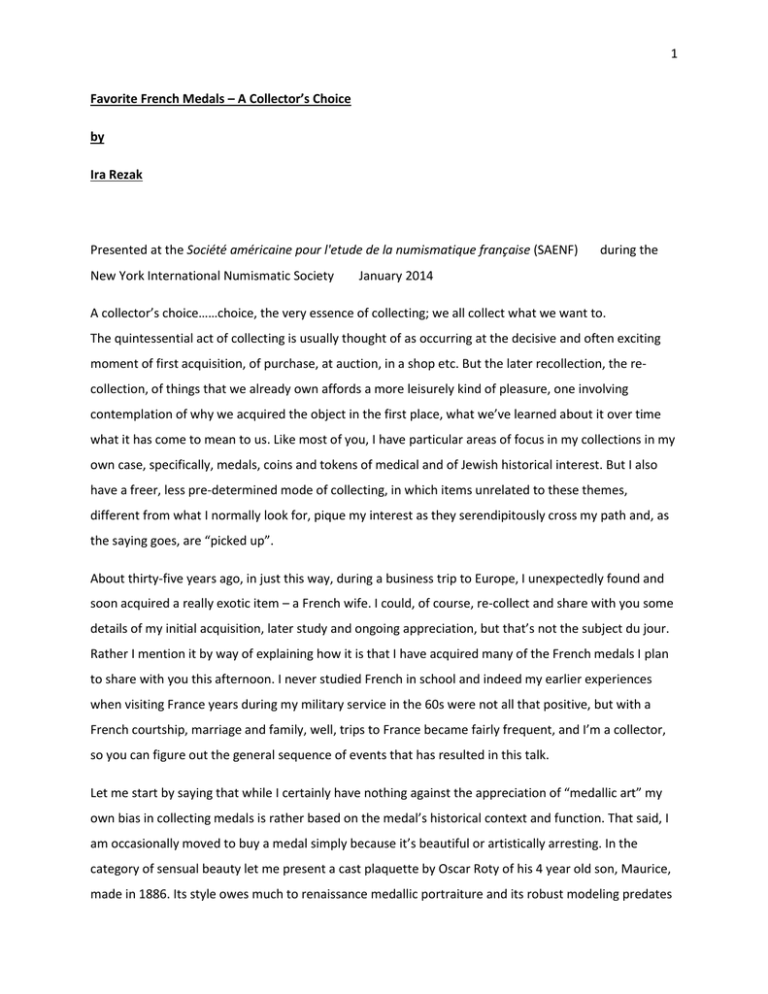
1 Favorite French Medals – A Collector’s Choice by Ira Rezak Presented at the Société américaine pour l'etude de la numismatique française (SAENF) New York International Numismatic Society during the January 2014 A collector’s choice……choice, the very essence of collecting; we all collect what we want to. The quintessential act of collecting is usually thought of as occurring at the decisive and often exciting moment of first acquisition, of purchase, at auction, in a shop etc. But the later recollection, the recollection, of things that we already own affords a more leisurely kind of pleasure, one involving contemplation of why we acquired the object in the first place, what we’ve learned about it over time what it has come to mean to us. Like most of you, I have particular areas of focus in my collections in my own case, specifically, medals, coins and tokens of medical and of Jewish historical interest. But I also have a freer, less pre-determined mode of collecting, in which items unrelated to these themes, different from what I normally look for, pique my interest as they serendipitously cross my path and, as the saying goes, are “picked up”. About thirty-five years ago, in just this way, during a business trip to Europe, I unexpectedly found and soon acquired a really exotic item – a French wife. I could, of course, re-collect and share with you some details of my initial acquisition, later study and ongoing appreciation, but that’s not the subject du jour. Rather I mention it by way of explaining how it is that I have acquired many of the French medals I plan to share with you this afternoon. I never studied French in school and indeed my earlier experiences when visiting France years during my military service in the 60s were not all that positive, but with a French courtship, marriage and family, well, trips to France became fairly frequent, and I’m a collector, so you can figure out the general sequence of events that has resulted in this talk. Let me start by saying that while I certainly have nothing against the appreciation of “medallic art” my own bias in collecting medals is rather based on the medal’s historical context and function. That said, I am occasionally moved to buy a medal simply because it’s beautiful or artistically arresting. In the category of sensual beauty let me present a cast plaquette by Oscar Roty of his 4 year old son, Maurice, made in 1886. Its style owes much to renaissance medallic portraiture and its robust modeling predates 2 the use of the ever lower relief, by this artist and many others, that was to become more popular as the century ended. The reverse of budding cherry blossoms echoes the tenderness of the young boy. A very different esthetic informs the two-part medal of Jonah and the whale by Rene Quillivic issued in the 1970’s during the period when the Paris Mint encouraged modernist innovation…this is one of the earlier iterations of a double medal with an inside and an outside… a presentation quite appropriate to the theme of Jonah. 3 Another innovative medal, but of an earlier age, is this plaquette an advertising an artistic contest that was sponsored by the newspaper Le Gaulois in 1901. By an artist named Morceaux, the form of this cast piece reproduces the outline of the newspaper itself, folded and banded for delivery so faithfully that even its edges clearly show multiple pages. The paper’s owner and editor, Arthur Meyer, was the grandson of a rabbi but a Catholic convert who married into the nobility and during the Dreyfus affair was an anti-Dreyfusard, upholding and promoting the earlier court verdicts that had convicted Alfred Dreyfus. His newspaper more generally was a principal channel for right wing and upscale social gossip. 4 Political commentary was a major theme on popular French medals of the 19th Century. Several examples of this usage have fallen into my hands. One exemplar is an anonymous medal which execrates Charles X for his bloody attempt at suppressing the July Revolution of 1830 that soon led to his abdication and the end of Bourbon rule in France. On it Charles is described as worse than his remote ancestor, Charles IX, during whose reign the infamous St Batholemew’s Day massacre of Hugenots occured. Though the medal lacks any iconography it is of interest because it claims to have been struck from the lead of the very bullets that caused the massacre of anti-royalist protestors during the first days of the July Revolution. Charles X was a younger brother of both Louis XVI who was guillotined in 1793 and of Louis XVIII who reigned briefly after the post Napoleonic Bourbon restoration. Born in the Ancien Regime in 1757 Charles during most of his life was known as the Count of Artois. 5 In 1775 the Count was married to a Savoy princess at the Hotel de Menus Plaisirs in Versailles. Special medallions were manufactured for this specific occasion as badges to be worn as identification by the servants. An example shows that though these too lacked iconography they were nevertheless cast in bronze with considerable care as evidenced by the complexity of the loop suspensions. 6 A later moment in Bourbon history was marked by the hope for a second restoration in the person of the pretender, Henri V. Henry, born in 1820, was the son of the Duke of Berri, and the grandson of the “execrable” Charles X. Consequently at various interregnal points in French history Henri was an obvious legitimist candidate for a Bourbon restoration of the Monarchy. The text of this medal of 1848 is entirely in the form of a rebus. It associates the then 28 year-old claimant with his ancestor, Henri IV, who had brought an end to the wars of Religion in France after famously converting to Catholicism and saying that Paris was “well worth a mass” and who later issued the Edict of Nantes that legitimated Protestant worship in France. Henri V, also known as the Count of Chambord, lived into the 1880s and, though he never made it to the throne, was repeatedly touted numismatically as a potential monarch well into his middle age. Several other political items have turned up and appealed to my curiosity over the years. A particularly interesting piece is an aftercast of a medal of Napoleon originally issued when he was still First Consul. However this copy had its original text has been removed and replaced by a hand engraved inscription commemorating the entry of Napoleon’s army into Moscow in 1812. One cannot be certain that this souvenir was created on the spot in Moscow by someone travelling with the army at that time, but that theory does seem to me plausible. I understand that copies of this very medal, what the Russians would 7 call “novodels”, were later die-struck in France. For many years I collected Russian coins and medals which explains why this piece landed in my collection. A further remnant of my now dispersed Russian collection is a tiny medal of Alexander I, only 7 mm in diameter. It’s a reminder of the final defeat of Napoleon in 1815, though not of Alexander’s triumphal entry into Paris which occurred in April 1814, right after Waterloo, and which proved the occasion for a great many commemorative medals depicting the victorious Allied sovereigns and generals. Another Eastern European-French connection is recalled on a medals commemorating, or rather execrating, the so-called Galician massacre of 1846. The Franco-Polish connection was of some antiquity and complexity. Henry III of France had during his French reign been elected King of Poland and Grand Duke of Lithuania in the 1570s. The Polish nobility, like that of France, was largely dispossessed in the late 18th century at about the time of the French Revolution when Poland was partitioned by the recurrent incursions of Prussia, Austria and Russia. The status of the Polish Nobility was restored to some extent during the existence of the Napoleonic Duchy of Warsaw. In 1846, however, the nobility of Krakow rose up against the repressive Austrian occupation that had been instituted by the Congress of Vienna. The uprising was quickly crushed by Austrian forces aided, incidentally, by the local Polish peasantry who had little affection for their native nobility. A massacre occurred in Krakow and Western Poland which inspired two medals by David d’Angers, on both of which a “democratic” France is 8 represented as recording and execrating the massacres in Galicia. France at this time was in the final two years of the reign of Louis-Philippe. It was then a stamping grounds for the likes of Karl Marx and other socialists but hardly qualified as a democracy as the revolution of 1848 was soon to demonstrate. A couple of other French numismatic items also comment on contemporary political tensions in Europe. The first is an altered 50 centime coin of 1916 which was clearly Sovietized by the skillful use of a jeweler’s saw, presumably soon after the 1917 October Revolution in Russia. It seems originally to have been a badge of some sort, to be worn openly by socialist or communist sympathizers in France, but its 9 screw back has since been removed from the reverse side perhaps to make it more collectible. A second piece is a more traditional product of the medallic art. but casts a revealing light on the period in which it was conceived and circulated. It is dated 1939, not long after the French Prime Minister, Edouard Daladier, joined Neville Chamberlain in signing the notorious Munich agreement which condemned Czechoslovakia to dismemberment and confirmed for many observers the aggressive nature of Nazi Germany and the imminence of a general European conflict. But the medal itself shows Daladier looking as confident as possible, though not very convincingly, as he urges confidence that France will “overcome”. What is to be overcome is left unspecified, though thunderheads and lightning bolts bouncing off a French liberty cap scarcely distinguishable from a shield certainly suggest that the danger is not an economic depression but something more violent. The reverse motive of an olive tree and a continuation of the obverse text seems to make it quite explicit what it is that France was to overcome for the benefit of peace and humanity. With war mere months away and the handwriting clearly on the wall this effort at propaganda appears to display more wishful thinking that actual confidence. The medal of Napoleon in Moscow and the Sovietized 50 centime coin are examples of my own ongoing interest in hand-engraved medals. Some might say that such hand worked objects aren’t really medals, and should be relegated to some other category. But any collector may simply trump any such intrusive suggestions by asserting his privilege of choosing to characterize and collect whatever he or she pleases. For me, individually engraved things have an extra dollop of immediacy, extra proof that they were “there” at a specific moment in time and place. Actually that’s one of the reasons I value medals in the 10 first place, because their materiality, their having been somewhere, having played an actual role in history, is what gives me the feeling that I am personally closer to the events they record. With that in mind let me share a few such items that have come my way. A dollar-sized brass piece records the names and birth dates of two individuals separated by 18 years, 1722 and 1740. Obviously, the names are French but the supporting text is English. Given the character and quality of the engraving it was not difficult to imagine that those named were French Hugenots in England who, as is well known, dominated the silversmithing trade in London at this time. Indeed, it’s been possible to trace an Abraham Buteaux who is recorded as having been christened at Threadneedle Street on July 22, 1722 some two weeks after the reported birth date. His father, also named Abraham Buteaux 1698-1731, is known to have been a silversmith and his wares are readily found listed on the internet. Who actually engraved the birth medal is unknown, but it was more likely a worker in the atelier than the master himself. Of Peter Bouvier I have found nothing so far, but a Francois Bouvier was known to be a “Foreign Artist of the Reformed Faith” in England by 1609 and a Jean Bouvier was a member of the French Church in Glass House Street, London, in 1699. So Peter too was most likely also the son of a Hugenot silversmith. 11 More usual examples of engraving on medals were produced either as memorabilia or as prizes, and were normally one of a kind. The 1766 School of Mathematics Prize from Lille in Baroque style is actually signed by J.C.D. Merche, who was Graveur des Etats in that City. Of course, engravers worked mostly in the negative, to produce printed material on paper. Merche is known to have made bookplates and also religious pictures in 1776. Whether he made other medals is unclear. During the French revolutionary period, as is well known, a completely novel calendar, with dates and festivals reckoned differently, was instituted and operated from 1791 to 1805. In this period one of the Civic Holidays to be celebrated at the cantonal level was the Fete des Viellards, what we today might term Senior Citizens Day. And so, in the Canton of Villejuif, near Paris, on the 10th of Fructidor in the year 7, which would have been in August 1797, such a festival honored Citizen Letellier who’d reached the remarkable age of 89 with a silver medal. A third engraved piece is a school prize from Albi (the former home of the Albingensian Cathars) near Toulouse which was awarded to an unnamed student for translations. 12 Finally, in this genre, an unusual medical presentation piece. Designed to be worn as a badge of honor and remarkably festooned with stones of various colors in imitation of an Order of Chivalry, the reverse is engraved with the real story. In 1841 the membership of the Philanthropic Societies of Paris with this medal honored a Dr Goujon de Beauvivier, a physician who treated the poor equally as he dealt with the wealthy and, as the inscription indicates did not turn away hopeless cases. He was specifically noted for caring for patients at the Apostolic Hospital and for the many victims of Cholera epidemic in the 1830s. Aside from the main dedicatory text the names of many notables, philanthropists and physicians are inscribed are engraved on the badge’s reverse. 13 Another subject that has piqued my interest is numismatica in nummis, that is, medals dealing with medalists, collectors or medallic technique. A few examples will illustrate the range of types. The “Hommage aux Graveurs francais” by Alphonse Eugene Lechevrel of 1891 names on a plinth more than ten eminent contemporary French medalists including Oudine, Chaplain, Roty, Dupuis, Bottee, Pate, Vernon, Dubois, and Francois. The encomium on the ribbon above is “Magistris Caelatoribus Gloria in Aeternum” (Eternal glory to the master medalists). 14 Lechevrel also made a plaque of A. Liard a distinguished founder of medals for British as well as French artists..but why his name is displayed as a mirror image is unclear to me. The well known portrait of Marie de Medici by Dupre c 1624 (here as an electrotype) also had mirrored inscriptions but these have been explained as indicating that her royal titles and status were but a reflection of her son, Louis XIII’s glory. So, here as in several other cases I’m hoping that some of you, who doubtless know more about French medals and their history than I do, may offer some suggestions or corrections. 15 Many medalists in France produced medals by way of advertising their own professional services and these often display illustrations of minting or engraving techniques, current or ancient.Several advertisements and commemoratives of the Canale firm emphasize the engraving of medals, both in the present and in antiquity, but here the actual artist who designed the advertising medal of 1927 and charming art deco advertising token of 1932 was the distinguished medalist, Henry Dropsy rather than Canale himself. 16 Janvier and Duval produced these two plaquettes which show, respectively, the hand-striking of coins in antiquity and the later use of the screw press or balancier technique. However both reverses speak of, and one even demonstrates, that their machinery could reduce models as well as strike medals. Interestingly, a much earlier provider of mechanical reductions also has left us a small advertising token. This was Achille Collas (1795-1859) the inventor and proprietor of two machines of interest to numismatists. In 1833 Collas publically displayed examples of what he called “numismatic engravings” These were printed reductionsin two dimensions of medallions that were in fact reliefs in three dimensions - essentially his device engraved on a printing plate a series of irregular lines, much as are used to indicate topography on maps, that gave the effect of three dimensionality. Invented before photography, this was a sensational and economically practical improvement over the line drawings and woodcuts that had previously been the standard method of numismatic illustration previously. The extensive and well known series Tresor de Numismatique et de Glyptique was produced using this method between 1834 and 1850. 17 An example of this method found in the 1836 volume of the Tresor dedicated to the French revolutionary period shows Dominique-Vivant Denon (1747-1825) a savant who served in many capacities related to the arts during the Napoleonic era. On the medal here illustrated Denon is shown as an archeologist who accompanied the French expedition to Egypt in 1798. This medal, described in the Tresor as being unpublished and at that time in the collection of Madame Soehnee; it was later sold when her collection was auctioned at the Hotel Drouot in 1872.Interestingly, I seem to have come upon the very medal that was used as the model for this illustration. A comparison of the reverses of the medal and of the illustration in the Tresor shows identical casting defects in both. It seems to be unrecorded elsewhere but these two points in time, 1836 and 1872, provide an unusually precise provenance for a particular Napoleonic medal. The medal is signed on the truncation of the bust but the signature is indistinct. (Possibly in reads Bernier, a medalist of this period who also made a portrait of Benjamin Franklin). As Collas’ advertising token indicates, he patented (in 1836) a more lasting invention, a pantograph capable of reducing in size and reproducing three-dimensional statuary. This machinery is believed to have been responsible for the ready and relatively inexpensive manufacture and hence popularization of small statuary in the latter half of the 19th Century. 18 19 In the course of collecting medals in France I’ve run across any number of items referencing America, and as I earlier suggested, I could use some help in figuring out just what they might mean. Take for example a pair of medalets of the great Paris Exposition of 1867 that tout a “Systeme Americain”. Because the obverse of one mentions hygiene I’ve assumed this has something to do with medicine, but though I travel in medical historical circles and have asked French specialists of the period for clues, so far I’ve learned nothing about such a system. Then there’s the medal of a Societe Americaine de France associated with one Lucien De Rosny of 1871 or soon thereafter. The humorous rooster on the reverse suggests some sort of social club or convivial society..but, again, frankly I haven’t a clue. 20 An interesting medal is that honoring George Blumenthal, a German born banker, head of Lazard Freres in New York, the longtime president of Mt Sinai Hospital there and also of the Metropolitan Museum of Art. He donated a great deal of money to the Museum including the funds for the famous Spanish Renaissance court, which is just to the left of the main staircase as one enters the Museum. The undated medal by Andre Rivaud, apparently made while Blumenthal, who died in 1941, was still alive refers to the Fondation Americaine pour l’Pensee et l’Art Francaise. This organization had originally been founded by his wife and presented a Prix Blumenthal that supported budding French artists at 10,000 francs/year for two years, and whose jurors included the likes of Henri Bergson, Jean Giradoux, Aristide Maillol and Maurice Ravel. The medal itself seems not to have had anything to do with the prize awarded by the foundation though, and it is unknown to the Metropolitan Museum and so, again, remains of rather obscure origin and purpose. 21 Lest you think that I only collect rare or imposing medals let me show you a few rather minor items each of which, however, wormed its way into my collection independently of any of the aforementioned categorical interests. The small anonymous gymnastics prize issued at Vichy in 1932 is a blend of Art Deco angularity and its related trope of proto-fascistic lock-step performance. A dance professors union’s insignia seems to claim that dance provides primary training for much if not all social, moral and physical development. A child watering flowers in a window box in this pendant is partly struck medal and partly formed by hand-twisted silver wire. A calendrical medal, apparently from the early 1920s, promotes the sale of mechanical calculators advertised somewhat jarringly as Steel Brains. Then there’s a 43 mm cast uniface medallic portrait of a child, titled David and dated 1827…whether the child’s name was David, or whether this might be a minor work of the David d’Angers is unknown to me. It is the case, however, that David d’Angers was active in England and Germany in 1827-1829 where he often did portraits from life quite apart from his extensive portrait series of famous men and women. 22 Paris in the 19th and 20th Centuries was, of course, a magnet for artists of all sorts, not least for sculptors and medallists. Felix Rasumny (1869-1940) was an immigrant from the Ukraine who had a long and active career as a medallist in Paris. But beyond this I have the sense that he was part of a group of Jewish artists who consorted with, supported, and trained each other around the turn of the 20th 23 Century. An electrotype medallion of his father, presumably the primary immigrant, identifies the father as coming from Smela, a small town, a shtetl, halfway between Kiev and Odessa that in his lifetime was 50% Jewish. The electrotype plaquette showing Rasumny as a young man in 1893 is signed by Michael Jampolsky, another Jew from the Ukraine who was a trainee of Rasumny, and who flourished before the First World War but then disappeared from view. Both of these electrotypes came from a small hoard of Jampolsky and Rasumny works that surfaced about 10 years ago in Paris and which contained many portraits, about half of which were of Jewish persons. A rather more famous Ukrainian-Jewish medallic immigrant to Paris was Israel Roukhomovsky, the creator of a famous forgery, the Tiara of Saitapharnes. Southern Russia was the site of a great many grave tumuli that were explored in the late 19th Century and yielded up much sought after ancient Greek and Scythian gold objects. When a golden tiara bearing the name of a historical Scythian king named Saitapharnes was offered for sale in 1896 its authenticity was questioned. Berlin declined the opportunity to purchase it but The Louvre bought it after raising 500,000 francs by public subscription for the purpose. In 1903, Israel Roukhomovsky showed up in Paris from Odessa and let it be known that he himself had made the tiara, to be sure not as an intentional forgery, but based on the particular specifications of someone else who had commissioned the piece and who later peddled it around Europe. Disbelieved at first, Roukhomovsky soon demonstrated convincingly that he had indeed made 24 the piece. It was then removed from public view amidst an uproar of embarrassing public scandal. The episode was much documented in text and cartoon and one of Roukhomovsky’s sons made two plaques which illustrate first, the triumphant metaphorical resurrection of Saitapharnes in 1896 followed in 1903 by his shameful retreat into the tomb as putti of truth removed his fake tiara. Roukhomovsky, who was really a spectacularly skilled goldsmith, and his children then settled in Paris where they made exquisite objects de vertu for the Rothschilds and other eminences. 25 Of course, a great many other medals might be cited by way of illustrating French medallic art but, in closing, let me show this final example, of rather recent vintage, that addresses, both literally and figuratively, many of the issues pertinent to the conception, creation, and appreciation of medals. The obverse has a celator and a connoisseur,with both encircled by a medallic beaded border. The artist, Raymond Tschudin, has also supplied as text three traditional medallic concepts: symbolism, synthesis and balance. The reverse of the medal, in addition to a conventional screw-press, shows other human figures contemplating - a mythical figure, Pegasus, a model statue, and each other, man and women – all of which illustrate traditional and recurrent medallic tropes. These figures are themselves in turn surrounded by a scattering of familiar and yet somewhat mystical graphic symbols. 26 So there’s an end to this collector’s choice of French medals for show and tell. Ira Rezak
